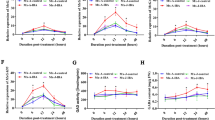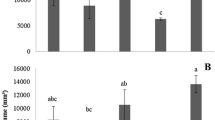Abstract
Application of a sublethal dose of glyphosate (N-[phosphonomethyl]glycine) to the seedlings of soybean (Glycine max L. Merr. cv. Evans) and pea (Pisum sativum L. cv. Alaska) promoted growth of the cotyledonary and other lateral buds. The pattern of the glyphosate-induced lateral bud growth was different from that induced by decapitation. Under the experimental condition, glyphosate did not kill the apical buds. Feeding stem sections of the seedlings with radiolabeled indole-3-acetic acid ([214C]IAA) and subsequent analysis of free [2-14C]IAA and metabolite fractions revealed that the glyphosate-treated plants had higher rates of IAA metabolism than the control plants. The treated pea plants metabolized 75% of [2-14C]IAA taken up in the 4-h incubation period compared to 46.5% for the control, an increase of 61%. The increase was small but consistent in soybean seedlings. As a result, the glyphosate-treated plants had less free IAA and ethylene than the control plants. The increase of IAA metabolism induced by glyphosate is likely to change the auxin-cytokinin balance and contribute to the release of lateral buds from apical dominance in these plants.
Similar content being viewed by others
References
Abu-Irmaileh BE, Jordan LS (1978) Some aspects of glyphosate action in purple nutsedge (Cyperus rotundas). Weed Sci 26:700–703
Ali A, Fletcher RA (1970) Hormonal regulation of apical dominance in soybeans. Can J Bot 48:1989–1994
Amrhein N, Schab J, Steinrucken HC (1980) The mode of action of the herbicide glyphosate. Naturwissenschaften 67:356–357
Baur JR (1979a) Effect of glyphosate on auxin transport in corn and cotton tissues. Plant Physiol 63:882–886
Baur JR (1979b) Reduction of glyphosate-induced tillering in sorghum (Sorghum bicolor) by several chemicals. Weed Sci 27:69–73
Baur JR, Bovey RW, Veech JA (1977) Growth responses in sorghum and wheat induced by glyphosate. Weed Sci 25:238–240
Berlin J, Witte L (1981) Effects of glyphosate on shikimic acid accumulation in tobacco cell cultures with low and high yields of cinnamoyl putrescines. Z Naturforsch 36c:210–214
Brecke BJ (1976) Studies on the mechanism of action of N-(phosphonomethyl)glycine (glyphosate). PhD dissertation, Cornell University, Ithaca, New York
Brecke BJ, Duke WB (1980) Effect of glyphosate on intact bean plants (Phaseolus vulgaris L.) and isolated cells. Plant Physiol 66:656–659
Caseley JC (1972) The effect of environmental factors on the performance of glyphosate againstAgropyron repens. Proc Br Weed Control Conf 11:641–647
Catalano M, Hill TA (1969) Interaction between gibberellic acid and kinetin in overcoming apical dominance, natural and induced by IAA, in tomato (Lycopersicum esculentum Mill cv. Potentate). Nature (Lond) 222:985–986
Cole DJ, Dodge AD, Caseley JC (1979) Effects of glyphosate on protein synthesis and phenylalanine metabolism in rhizome buds ofAgropyron repens. Plant Physiol 63 (Suppl):96
Comai L, Sen LC, Stalker DM (1983) An altered aroA gene-product confers resistance to the herbicide glyphosate. Science 221:370–371
Duke SO, Hoagland RE (1978) Effects of glyphosate on metabolism of phenolic compounds. I. Induction of phenylalanine ammonioalyase activity in dark-grown maize roots. Plant Sci Lett 11:185–190
Duke SO, Wauchope RD, Hoagland RE, Wills GD (1983) Influence of glyphosate on uptake and translocation of calcium ion in soybean seedlings. Weed Res 23:133–139
Fernandez CH (1976) Studies on penetration and translocation of glyphosate (N-phosphonomethylglycine) onCynodon dactylon L. Pers. MSc thesis, University of California, Davis
Hoagland RE, Duke SO, Elmore D (1978) Effects of glyphosate on metabolism of phenolic compounds. 2. Influence on soluble hydroxyphenolic compound, free amino acid and soluble protein levels in dark-grown maize roots. Plant Sci Lett 13:291–299
Holländer H, Amrhein N (1980) The site of the inhibition of the shikimate pathway by glyphosate. I. Inhibition by glyphosate of phenylpropanoid synthesis in buckwheat (Fagopyrum esculetum Moench). Plant Physiol 66:823–829
Kitchen LM, Witt WW (1981) Inhibition of chlorophyll accumulation by glyphosate. Weed Sci 29:513–516
Kubowicz BD, Vanderhoef LN, Hanson JB (1982) ATP-dependent calcium transport in plasmalemma preparations from soybean hypocotyls. Effect of hormone treatment. Plant Physiol 69:187–191
Langer RHM, Prasad PC, Laude HM (1973) Effects of kinetin on tiller bud elongation in wheat (Triticum aestivum L.). Ann Bot 37:565–571
Lee TT (1980a) Effects of phenolic substances on metabolism of exogenous indole-3-acetic acid in maize stems. Physiol Plant 50:107–112
Lee TT (1980b) Characteristics of glyphosate inhibition of growth in soybean and tobacco callus cultures. Weed Res 20:365–369
Lee TT (1981) Effects of glyphosate on synthesis and degradation of chlorophyll in soybean and tobacco cells. Weed Res 21:161–164
Lee TT (1982a) Mode of action of glyphosate in relation to metabolism of indole-3-acetic acid. Physiol Plant 54:289–294
Lee TT (1982b) Promotion of indole-3-acetic acid oxidation by glyphosate in tobacco callus tissue. J Plant Growth Regul 1:37–48
Lee TT, Dumas T (1983) Effect of glyphosate on ethylene production in tabacco callus. Plant Physiol 72:855–857
Leopold AC (1949) The control of tillering in grasses by auxin. Am J Bot 36:437–440
Nickell LG (1982) Plant growth regulators. Agricultural uses. Springer-Verlag, New York
Panigrahi BM, Audus LJ (1966) Apical dominance inVicia faba. Ann Bot 30:457–473
Pillay I, Railton ID (1983) Complete release of auxiliary buds from apical dominance in intact, light-grown seedlings ofPisum sativum L. following a single application of cytokinin. Plant Physiol 71:972–974
Rogers SG, Brand LA, Holder SB, Sharps ES, Brackin MJ (1983) Amplification of the aroA gene fromEscherichia coli results in tolerance to the herbicide glyphosate. Appl. Environ Microbiol 46:37–43
Sachs T, Thimann KV (1964) Release of lateral buds from apical dominance. Nature (Lond) 201:939–940
Schaeffer GW, Sharp F Jr (1969) Release of auxiliary bud inhibition with benzyladenine in tobacco. Bot Gaz 130:107–110
Thimann KV, Skoog F (1934) On the inhibition of bud development and other functions of growth substances inVicia faba. Proc R Soc (Lond) B 114:317–339
Wickson ME, Thimann KV (1958) The antagonism of auxin and kinetin in apical dominance. Physiol Plant 11:62–74
Author information
Authors and Affiliations
Rights and permissions
About this article
Cite this article
Lee, T.T. Release of lateral buds from apical dominance by glyphosate in soybean and pea seedlings. J Plant Growth Regul 3, 227–235 (1984). https://doi.org/10.1007/BF02042007
Received:
Accepted:
Issue Date:
DOI: https://doi.org/10.1007/BF02042007




